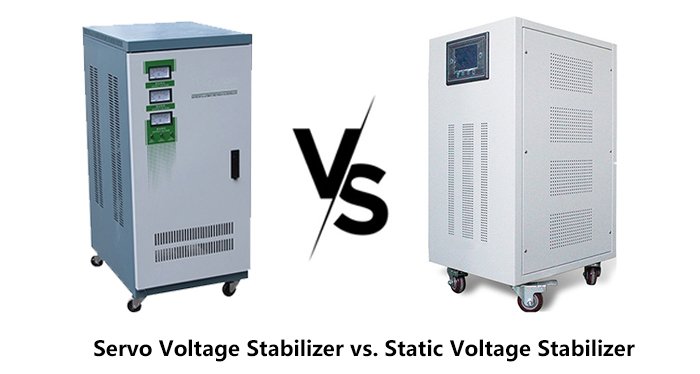Voltage stabilizers have become an integral part of many households, industrial and commercial system appliances. Earlier, manually operated or switchable voltage regulators were used to boost or step down the input voltage to provide an output voltage within the desired range. This stabilizer is built with electromechanical relays as switching devices.
Later, additional electronic circuits automated the stabilization process and gave rise to the tap-changer automatic voltage stabilizers. Another popular voltage stabilizer is the servo regulator, which performs voltage correction continuously without any switching. Choosing a suitable voltage stabilizer is very important. Let’s discuss the three main types of voltage stabilizers, and which type is better for your applications.
In this type of voltage stabilizer, voltage regulation is achieved by switching a relay to connect one of the transformer’s multiple taps to the load (as discussed above), whether for step-up operation or step-down operation. The diagram below illustrates the internal circuit of a relay stabilizer.
Relay type voltage stabilizer

In addition to the transformer (which can be a toroidal or iron core transformer with taps on its secondary), it has electronic circuits and a set of relays. Electronic circuits include tiny components such as rectifier circuits, operational amplifiers, and microcontroller units.
An electronic circuit compares the output voltage with a reference value provided by a built-in reference voltage source. Whenever the voltage rises or falls above the reference, the control circuit switches the corresponding relay to connect the desired tap to the output.
These voltage stabilizers typically change the voltage for ±15% to ±6% input voltage variations, with output voltage accuracy of ±5% to ±10%. This type of stabilizer is most commonly used on low-rated appliances in residential, commercial, and industrial applications because of its lightweight and low cost. However, these suffer from limitations such as slow voltage correction, poor robustness, low reliability, interruption of the power path during regulation, and inability to withstand high voltage surges.
Servo voltage stabilizer
These are simply called servo-based stabilizers (working on a servomechanism, also known as negative feedback) and, as the name suggests, use a servo motor to achieve voltage correction. These are primarily used for high output voltage accuracy, typically ±1%, with input voltage variations up to ±50%. The figure below shows the internal circuit of the servo stabilizer, which contains the servo motor, auto-transformer, buck-boost transformer, motor driver, and control circuit as basic components.
In this regulator, one end of the primary of the buck-boost transformer is connected to a fixed tap of an auto-transformer, and the other end is connected to a boom controlled by a servo motor. The secondary of the buck-boost transformer is connected in series with the input power supply, which is just the stabilizer output.
The electronic control circuit detects voltage dips and voltage rises by comparing the input to a built-in reference voltage source. When the circuit sees an error, it runs the motor, which in turn moves the arms on the auto-transformer. This powers the primary of the buck-boost transformer so that the voltage across the secondary should be the desired voltage output. Most servo stabilizers use an embedded microcontroller or processor as the control circuit for intelligent control.
These stabilizers can be single-phase, three-phase balanced, or three-phase unbalanced devices. In the single-phase type, a servo motor coupled with a variable transformer implements voltage correction. In the case of the three-phase balanced type, the servo motor is coupled with three autotransformers, which provide a stable output during fluctuations by adjusting the output of the transformers. In an unbalanced servo stabilizer, three independent servo motors are coupled with three autotransformers, which have three independent control circuits.
Compared with relay-type stabilizers, the use of servo stabilizers has several advantages. Some of them are higher correction speed, stable output with high accuracy, ability to withstand inrush current, and high reliability. However, these require regular maintenance due to the presence of the motor.

Static voltage stabilizer
The static stabilizer does not have any moving parts as the servo motor mechanism of the servo stabilizer. It uses a power electronic converter circuit to achieve voltage regulation instead of an auto-transformer as is the case with traditional voltage regulators. Compared to servo stabilizers, these stabilizers can produce higher accuracy and excellent voltage regulation, typically ±1% regulation.
It mainly consists of a step-down step-up transformer, an IGBT power converter (or AC to AC converter), and a microcontroller, microprocessor, or DSP-based controller. A microprocessor-controlled IGBT converter generates the right amount of voltage through a pulse width modulation technique and supplies this voltage to the primary of the buck-boost transformer. The voltage produced by the IGBT converter can be in-phase or 180 degrees out of phase with the incoming line voltage in order to perform voltage addition and subtraction during fluctuations.
Whenever the microprocessor detects a voltage dip, it sends PWM pulses to the IGBT converter, causing it to produce a voltage equal to the deviation from the nominal value. This output is in phase with the input supply and is supplied to the primary of the buck-boost transformer. Since the secondary is connected to the input line, the induced voltage will be added to the input power supply and provide this corrected voltage to the load.
Similarly, a voltage rise will cause the microprocessor circuit to send PWM pulses so that the converter will output an offset voltage that is 180 degrees out of phase with the input voltage. This voltage on the secondary side of the buck-boost transformer is subtracted from the input voltage in order to perform the step-down operation.
